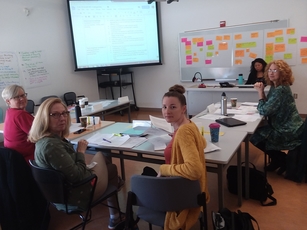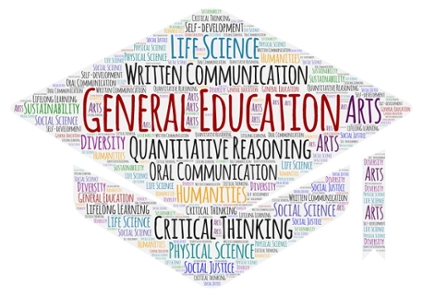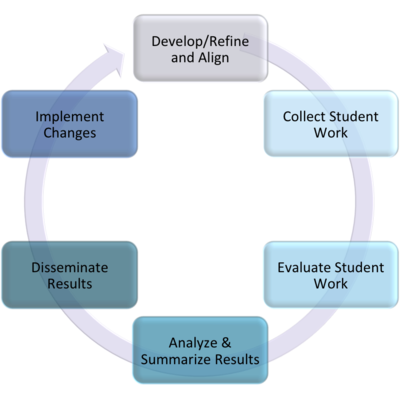GE/Breadth Assessment
PURPOSE
![]()
The overarching purpose of GE assessment at CSUEB is to enhance undergraduate student learning and improve the learning experiences afforded by the GE program. Looking beyond the CSU Chancellor's Office and WASC accreditation requirements which necessitate GE assessment, the true value of GE assessment lies in how we collaboratively make meaning of assessment results to inform improvements in GE.
GUIDING PRINCIPLES
♥ GE assessment serves to enhance student learning and improve the learning experiences afforded by the GE program.
♥ GE assessment requires faculty engagement and is a faculty-driven process with assessment work and decisions governed by faculty and faculty committees.
♥ GE assessment is never punitive, and assessment results are never used against faculty (e.g., in retention, tenure, and promotion decisions) or programs (e.g., resource allocation).
♥ GE assessment practices assure the anonymity of faculty participants and protect the confidentiality of students and their work.
♥ GE assessment is distinct and separate from the GE course review and recertification process.
-
A draft of the GE A2 rubric was first developed by faculty in the Department of English in May 2018 and used for a pilot assessment of 1A (A2) in May 2019. This pilot informed revisions to the rubric, which were completed on June 10, 2019 by the English faculty members who served as assessors in the pilot project. The rubric was then updated in Spring 2023 and the second assessment took place in Spring 2024.

1A (A2) (2019) rubric development team from the Department of English. Shown left to right: Sarah Nielsen, Dore Ripley, Michelle St. George, Sally Baxter; Dabney Lyons (not shown).
The 1A rubric is used to assess signature assignments which are aligned to the rubric.
See the Revised 2023 GE Area 1A Written Communiction (First Year Composition) Rubric here.
You can find the Assessment Report from 2024 here.
You can find the Tableau dashboard assessment results here.
You can find the Student Survey Results from 2024 here.
Previous Assessment Results:
See the 2018 GE Area 1A Written Communication (First-Year Composition) Rubric here.
A summary of the results of the A2 assessment pilot is provided in the GE A2 Assessment Report 2019 here.
-
The A3 rubric was developed in November 2019 by faculty members in the Department of Philosophy in collaboration with the Office of General Education. The pilot project of collection and evaluation occurred in Spring 2021. An assessment summary was completed in Fall 2021. The learning outcomes and rubric were revised in Fall 2023 because of the assessment results. Note that in Fall 2025, Critical Thinking (A3) will be Critical Thinking and Composition (1B under the new GE pattern) to align it with the Board of Trustee approval of the new GE pattern. The learning outcomes have been created to put Critical Thinking together with Composition.
The A3 rubric is used to assess signature (comprehensive) assignments that are aligned to the A3 Critical Thinking rubric. See the GE Area A3 rubric here.
A summary of the results of the A3 assessment pilot is provided in the GE A3 Assessment Report here
-
The 1C (A1) rubric was developed in March 2020 by faculty members in the Department of Communication in collaboration with the Office of General Education. The rubric is used to assess established signature oral presentation and interpersonal communication assignments aligned to the rubric. Each dimension must be covered in the assignment and assessed independently.
View the GE Area 1C (A1) Oral Communication Rubric here.
A summary of the results of the 1C assessment pilot (2021) is provided in the GE A1 Assessment Report here.
-
Area 2 Assessment
The Area 2 (B4) rubric was developed by faculty members in the Department of Mathematics and in the Department of Statistics & Biostatistics in May 2019. The B4 Mathematics and Quantitative Reasoning pilot has completed a first round of collection and evaluation in Fall 2019. A second round was completed in Fall 2020. The rubric and learning outcomes were updated in Summer 2025.
You can find the revised learning outcomes and the revised rubric (2025) here.
Previous Assessment and Rubrics:
See the GE Area 2 (B4) Mathematics/Quantitative Reasoning Rubric here.
A summary of the results of the B4 assessment pilot from 2019/202 is provided in the GE B4 Assessment Report here
-
3A/3C (C1/2) Assessment
Some assignments have been collected in Spring 2024 and collection will continue in Spring 2025. Assessment of C1/2 will take place in Fall 2025.
The rubric was designed in Spring 2023 by a group of faculty who teach C1/2 courses.
View the C1/2 Arts/Humanities Rubric here.
-
Area 4 (D1/2) Assessment
The rubric was designed by a group of faculty who teach these courses in Fall 2023.
Area 4 (D1/2) assignments were collected in Fall 2024 and was assessed in Spring 2025.
View the Area 4 (D1/2) Rubric here.
-
Area 5A, 5B, and 5C (B1/2/3) Assessment
The Area 5A/5B (B1/2) Rubric was designed by 5A and 5B faculty in 2022/2023 and was used for assessment in Spring 2025.
View the B1/2 Rubric here.
You can find the Tableau 5A (B1) assessment results here.
You can find the 5A student survey results here.
You can find the Tableau 5B (B2) assessment results here.
You can find the 5B (B2) student survey results here.
5C (B3) (Lab) will be assessed through a student survey. Results will be posted after the 5C (B1/2) assessment has been completed.
-
Area 6 (Area F) Ethnic Studies Assessment
In Spring 2025 Area 6 faculty updated the Area 6 learning outcomes and created a rubric. Assignments will be collected in Spring 2026 and assessed in Fall 2026.
You can find the Area 6 Rubric and revised learning outcomes here.
-
Second Composition Assessment
A draft of the Second Composition rubric was developed by faculty in the Department of English and the Department of Art in September 2018. The rubric was revised in Fall 2023 and was used for assessment in Spring 2024.
See the Second Composition Rubric here.
You can find the Ttableau assessment results from 2024 here.
You can find the results of the student survey from 2024 here
-
U.S. Code 1 Assessment
The rubric was designed by a group of faculty who teach US 1 courses in Spring 2024.
Collection of student artifacts took place in Spring 2025 with assessment taking place in Fall 2025.
View the US Code 1 Rubric here.
-
U.S. Code 2 Assessment
Collection of student artifacts took place in Spring 2025 with assessment taking place in Fall 2025.
The rubric was designed by a group of faculty who teach US 2 courses in Spring 2024.
View the US Code 2 Rubric here.
-
U.S. Code 3 Assessment
Collection of student artifacts took place in Spring 2025 with assessment taking place in Fall 2025.
The rubric was designed by a group of faculty who teach US 3 courses in Spring 2024.
View the US Code 3 Rubric here.
-
In accordance with the GE Assessment long-term Plan:
- Assessment of all of US Code and C1/2 will take place in Fall 2025
- Area 2 assignments will be collected in Fall 2025 and assessed in Spring 2026
- Area 6 assignments will be collected in Spring 2026 and assessed in Fall 2026
- 1B Critical Thinking and Composition assignments will be collected in Spring 2026 and assessed in Fall 2026.
Please note: In Fall 2022 the university transitioned from Blackboard to Canvas as its LMS. Because of this, the usual assessment projects were paused for 2022-2023. Also note that the university is moving away from Google and will be using Microsoft products. This will entail creation of a new assessment tool using Microsoft products. It is hoped that the transition will not cause delays in assessment.

 GE assessment is currently progressing and has been been synchronized and coordinated with ILO assessment. The cycle assessment activities within each project cycle are grouped into the following categories (see figure):
GE assessment is currently progressing and has been been synchronized and coordinated with ILO assessment. The cycle assessment activities within each project cycle are grouped into the following categories (see figure):